Your Guide To Air Conditioner Installation In a Ductless House
Enjoy reading the latest DIY articles and saving money?
Receive our latest helpful hints, tricks and savings, directly to your inbox.
Posted April 24, 2020
Do you live in an old home without ductwork? Do you want to know about the easiest air conditioner installation for a home without a ductwork system?
In many cases, installing central air in a ductless house can be quick and painless. The operation can be simple and the cost might be lower than you think. What makes an air conditioner installation have both of these qualities is the right service team.
But, before you choose a professional solution, it’s important to know the ins and outs of servicing a home without a ductwork system. The more knowledgable you are, the better your life becomes. That said, if you want the logistics behind ductless air conditioner installation, keep reading for the answers you’ve been looking for.
Ductwork and Cooling Systems Briefly Explained

Before we go into the average cost to install central air and all your other big questions, let’s look at ductwork systems and how they work in short terms.
Ductwork
If your home doesn’t have a ductwork system, that simply means that you don’t have air ventilation passages to help distribute airflow throughout your house. In other words, a home without ductwork is one without built-in ventilation structures for helping air travel room to room.
Accordingly, ductwork is a stand-in word for airflow, meaning that a ductwork system is made of a series of conduits that help air travel in different directions. The absence of ducts doesn’t mean that you cannot have effective central air distributed through your home, it just means you’re going to need an alternative air conditioner installation.
Central Air Conditioning vs Ductless Air Conditioner
In most cases, a professional installs a central air conditioning unit in your home, connecting it to a series of ducts and fans. Doing this causes cooled air to spread through your home and often requires connected conduits and in many cases, more cash.
In your case, a ductless air conditioner is a similar unit that doesn’t require ductwork to work. As a result, one of the major benefits of a ductless air conditioner is that you have more options for installation. Since a ductless unit doesn’t require a forced-air furnace or ductwork, you can install one indoors or outdoors.
Consequently, a ductless conditioner is able to adapt to whatever zoning system you prefer. For instance, if you want to cool your living room yet warm up your bathroom, you can install two units and place them accordingly. Compared to central air which upon adjusting the thermostat regulates the same temperature for an entire floor.
Furthermore, a ductless air conditioner has the ability to heat or cool your home. Central air is restricted to cooling your home, while you can attach ductless options to heat pumps or furnaces for your choice of heating or cooling.
But, above all else, air conditioner installation for a ductless home is far easier than the alternative. Let’s explore that now.
Air Conditioner Installation

Installing a ductless air conditioner gives homeowners more leeway for where they want a unit and how they want their entire home cooled. The installation process depends on a few factors that we’ll explore:
- Placement
- Unit Type
- Cost and Installation
Placement
We offer a ductless mini-split system that both heats and cools your home. A mini-split air conditioner gives you the opportunity to adjust the temperature of zones or particular areas of your house. Here’s how it works.
A mini-split system has two parts, the first being an outdoor condenser that handles intake, and your choice of any number of indoor units. Once you have a condenser in place, you can choose where your indoor units go.
This flexibility allows you, the homeowner, to choose which parts of your home are heated or cooled. For instance, you might want to target the perimeter rooms of your house for the total surrounding air circulation. If your home has an atypical layout, you can make a plan with our professionals to figure out which unit placement works best for you and your needs.
Furthermore, each unit includes individual controls. So, if you want one room to remain cooler than the rest you can. This ends up being a big deal, as individual room adjustments can give you the chance to decide how much energy will be used room to room.
Unit Type
Let’s explore the ductless mini-split system more. For starters, you won’t need any kind of ductwork system in place to control the temperature of your home. The mini-split is unattached compared to traditional central air installations.
As mentioned above, a mini-split system is comprised of a condenser and any number of indoor units. A condenser actually applies pressure to refrigerated gas, then is pushed through your indoor units. The short form of this process can be summarized as heat transfer.
A little about that. Heat transfer is the process of cooling a natural gaseous substance to a liquid form.
This condensation exchanges energy to cool or heat an environment. The best example of this can be found in your refrigerator, which trades internal heat for the external air. You can think of this process as a Peltier, which aims to regulate a chosen temperature through the conversion of two temperatures.
This might seem complicated, so the easiest way to think of a condenser is as the outdoor filter that plugs into everything else. Once you have the condenser installed, you can start focusing on individual indoor units.
Your indoor units are complete with air handlers and blowers which circulate the air of your home. You can think of these separate units as your ductwork replacements. Once you have your indoor units and condenser, you only need refrigerant lines to connect everything together.
Cost and Installation
Air conditioner installation is simple as it only involves three components:
- A condenser
- Indoor units
- Connected refrigerant lines
Once these three parts are connected, you’re done with installation.
These steps are far easier to follow than for a central air system. As a result, installation costs are affordable. But, the biggest savings you’ll make come in the form of annual usage.
Let’s explore your savings.
Savings and Benefits

Mini-splits or ductless units give you flexible zoning for your home. This process alone can save you large amounts of money every year. For context, a central air system will regulate the temperature of your home as a whole.
As a result, other options like central cooling tend to cost a lot of money. Moreover, without the ability to selectively cool rooms, you tend to use more energy than is required for a given house.
Ductless air conditioners like the mini-split let you gauge and manage how much energy you use. That means you can control the budget of your energy bill directly. Of course, that’s not to mention how a ductless system can cool and heat your home.
Furthermore, you don’t have to worry about mini-splits losing their efficiency and costing you a fortune. Unlike central air, which relies on conduits that constantly are at risk of losing their efficiency, mini-splits lose little of what they give your home.
These are just some of the cost benefits that logically come to mind. But, there are more benefits worth exploring.
Health
Ductwork is notorious for gatherings molds, pests, and dust particles. As air travels through your ducts, these harmful pollutants start to infecting your breathable air. The cost of cleaning and repairing dirty ductwork can cost you lots of money over time.
However, a ductless system never has this problem. You can always rest well knowing that a mini-split conditioner is raising your indoor air quality.
Spacing
Ductwork takes up a lot of space. Trying to supply your home with central air is time-consuming and laborious, not to mention space-consuming. Moreover, you require more ductwork the larger home you have.
A ductless system lets you decide how much space you want. It gives you the freedom to design your home’s heating and cooling the way you like.
How to Make The Most of Your Air Conditioner System

If you’ve decided to go ductless, it’s a good idea to think about where you want your units placed and how many you need. So, before you start a conversation with an HVAC specialist, give your home a full sweep to figure out what you want.
For starters, do a walkthrough and decide which homes need the most temperature regulation. You may not need to heat or cool any of these rooms directly.
Secondly, take a long look at what your budget allows. You want to make the most of your AC, but you don’t want to exceed your budget. At this point, it’s a good idea to get a quote from your professional to see how many units will make sense for your home.
Air Circulation
It’s not a bad idea to experiment with airflow in different zones of your house. This will give you a better idea of the current air circulation you have available in each room. If your house has several stories, try playing around with airflow to see if the downstairs can catch wind of the upstairs.
Scheduling
You’re able to schedule when each room gets a blast of cool air. It’s a great idea to start thinking about your daily life in relationship to the state of your home’s heating and cooling. For example, if you work long days in the summer you’ll want to make sure you come home to an especially cool home.
However, if you work from home you might want several rooms to differ in scheduled temperature. Either way, it’s important to gauge what you want from your AC units before you make the actual purchase.
Your Alternatives

If you aren’t yet ready to choose a ductless system, there are many options available for a more efficient cooling system. One of your options is to find a safe system replacement that can cut your energy bill in half. Choosing an HVAC system replacement can resize and reshape your home heating and cooling.
If you’re still worried about energy efficiency, another option is to check out a learning thermostat. You can add this in tandem with your AC systems, resulting in a more environmentally friendly and energy-efficient household.
You can control a learning thermostat from your smartphone. This gives you the chance to change and manage the energy levels of your household from anywhere you go.
At the end of the day, choosing a ductless cooling system isn’t your only option. You can trust these alternatives to give you an easier time through the most bone-chilling or sweat-inducing of seasons.
Make a Happier Home

It’s no surprise to our past customers that choosing a team you can trust is just one of the secrets to a happier, healthier home. Today we looked at the logistics behind air conditioner installation in a home without a ductwork system. This post is meant to solve one of the few amenities every modern home needs: central air with heating and cooling.
Still, there are plenty of other everyday appliances and amenities to your household that need a fix or replacement every now and then. In order to make sure everything is running well, you’re going to need insight from someone you can rely on.
That’s where we come in. From HVAC to Plumbing, Happy Hiller is dedicated to making sure you and your family feel comfortable in your home.
If you have a problem, let us find a solution. Now that you’ve made it this far, go check out our promotions page for discounts and deals to ensure you end your day relaxing in a happier home.
 Daily Promotion
Daily Promotion
$500 Off Tankless Water Heater
Upgrade your comfort and give back this season.
Get Promotion